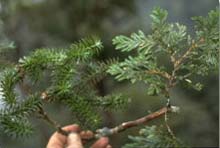Life Sciences and Chemistry
Articles and reports from the Life Sciences and chemistry area deal with applied and basic research into modern biology, chemistry and human medicine.
Valuable information can be found on a range of life sciences fields including bacteriology, biochemistry, bionics, bioinformatics, biophysics, biotechnology, genetics, geobotany, human biology, marine biology, microbiology, molecular biology, cellular biology, zoology, bioinorganic chemistry, microchemistry and environmental chemistry.

DNA shows genetic variability of the nene lost more than 500 years ago, not during the 20th century
Consider the plight of the lonely nene goose: Fated to occupy just one island in all the world; reduced in numbers to fewer than 30 individuals by the middle of the last century; each bird as closely related to the others as human siblings.
What caused the narrowing of the nenes’ circumstances to the point of near-extinction? Was the isolation of island living to blame for draining their gene pool to a puddle, or was it caused by the 20th century population decline? How did they surviv

Fish Blood Preserves Sperm
In the Arctic and Antarctic seas the water gets cold to minus 1.9 C in winter, but somehow some fish live there. These cold-blooded creatures survive in the icy water because the blood in their veins contains antifreeze proteins and glycoproteins. High levels of the antifreeze proteins are found in the blood serum, they are present in cell cytoplasm and all body fluids except urine. Due to their structure, molecules of antifreeze glycoproteins (AFGP) prevent growth of ice crystals. Natural antifreeze

Methamphetamine drastically increases virus’ ability to replicate in brain tissue
A controversial research study here has found that exposing cells infected with feline immunodeficiency virus – a surrogate for HIV – to methamphetamine increases those cells’ ability to replicate the deadly virus as much as 15-fold.
The finding, if confirmed by ongoing animal studies, could answer important questions about how lentiviruses such as FIV and HIV can gain a foothold in the brain. That knowledge is vital in slowing or lessening the dementia that often accompanies AIDS and s

Botanists Discover New Conifer Species in Vietnam
An unusual conifer found in a remote area of northern Vietnam has been identified as a genus and species previously unknown to science. The limestone ridges where the tree grows are among the most botanically rich areas in Vietnam, said Daniel Harder, currently director of the University of California at Santa Cruz (UCSC) Arboretum and a co-discoverer of the new species. The discovery is published in the current issue of the journal Novon.
“Biologists don’t need to contemplate finding life

Biochemist e-volution launched!
Biochemist e-volution – the site for life scientists – is an exciting new online magazine. With something new every day, it consists of:
~ daily news stories
~ the most comprehensive Diary of Events for life scientists
~ job adverts
~ training information
~ competitions and surveys
~ grants and awards news
~ book reviews
~ equipment and company news
~ the latest from The Biochemist magazine
“Over 60

HIRA, a new factor in the genome’s 3D organizational assembly chain
At the heart of every cell, vital information is “written” on the DNA, a long molecular ribbon almost one meter long bundled inside the nucleus of the cell. For the DNA to fit inside this small space, it is rolled up like a ball of yarn in a highly organized structure called chromatin. Beyond its purely structural role, the spatial organization of DNA is essential to the basic processes of a cell’s life because it provides information that is added to that contributed by the genetic code. This ball-